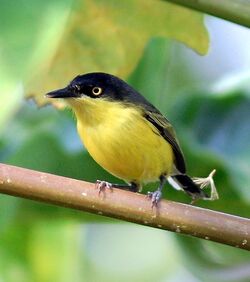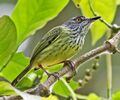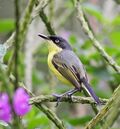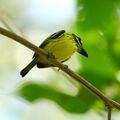Biology:Todirostrum
From HandWiki
Short description: Genus of birds
| Todirostrum | |
|---|---|

| |
| Common tody-flycatcher (Todirostrum cinereum) | |
| Scientific classification | |
| Domain: | Eukaryota |
| Kingdom: | Animalia |
| Phylum: | Chordata |
| Class: | Aves |
| Order: | Passeriformes |
| Family: | Tyrannidae |
| Genus: | Todirostrum Lesson, 1831 |
| Type species | |
| Todus cinereus Linnaeus, 1766
| |
| Species | |
|
see text | |
Todirostrum is a genus of Neotropical birds in the New World flycatcher family Tyrannidae.
Taxonomy and species list
The genus Todirostrum was erected in 1831 by the French naturalist René Lesson.[1] The type species was designated as the common tody-flycatcher by George Robert Gray in 1840.[2][3] The name combines the genus Todus introduced by Mathurin Jacques Brisson in 1760 with the Latin rostrum meaning "bill".[4]
It contains the following seven species:[5]
| Image | Name | Common name | Distribution |
|---|---|---|---|
 |
Todirostrum maculatum | Spotted tody-flycatcher | Bolivia, Brazil, Colombia, Ecuador, French Guiana, Guyana, Peru, Suriname, Trinidad and Tobago, and Venezuela |
 |
Todirostrum poliocephalum | Yellow-lored tody-flycatcher or grey-headed tody-flycatcher, | Brazil, occurring from Southern Bahia southwards to Santa Catarina |
 |
Todirostrum viridanum | Maracaibo tody-flycatcher, | Venezuela |
 |
Todirostrum nigriceps | Black-headed tody-flycatcher, | Colombia, Costa Rica, Ecuador, Panama, and Venezuela |
| Todirostrum pictum | Painted tody-flycatcher, | eastern-southeastern Venezuela and the northeastern states of Brazil of the Amazon Basin | |
 |
Todirostrum cinereum | Common tody-flycatcher or black-fronted tody-flycatcher, | southern Mexico to northwestern Peru, eastern Bolivia and southern Brazil. |
 |
Todirostrum chrysocrotaphum | Yellow-browed tody-flycatcher, | southern Amazon Basin of Brazil, also Amazonian Colombia, Ecuador, Peru, and Bolivia |
References
- ↑ Lesson, René (1831) (in French). Traité d'Ornithologie, ou Tableau Méthodique. Paris: F.G. Levrault. p. 384 (livraison 5). https://www.biodiversitylibrary.org/page/35997368. Published in 8 livraisons between 1830 and 1831. For dates see: Dickinson, E.C.; Overstreet, L.K.; Dowsett, R.J.; Bruce, M.D. (2011). Priority! The Dating of Scientific Names in Ornithology: a Directory to the literature and its reviewers. Northampton, UK: Aves Press. p. 119. ISBN 978-0-9568611-1-5. https://www.researchgate.net/publication/267763194.
- ↑ Gray, George Robert (1840). A List of the Genera of Birds : with an Indication of the Typical Species of Each Genus. London: R. and J.E. Taylor. p. 31. https://www.biodiversitylibrary.org/page/13668925.
- ↑ Traylor, Melvin A. Jr, ed (1979). Check-List of Birds of the World. 8. Cambridge, Massachusetts: Museum of Comparative Zoology. p. 87. https://www.biodiversitylibrary.org/page/14500864.
- ↑ Jobling, James A. (2010). The Helm Dictionary of Scientific Bird Names. London: Christopher Helm. p. 387. ISBN 978-1-4081-2501-4.
- ↑ Gill, Frank; Donsker, David; Rasmussen, Pamela, eds (2020). "Tyrant flycatchers". IOC World Bird List Version 10.2. International Ornithologists' Union. https://www.worldbirdnames.org/bow/flycatchers/. Retrieved 29 November 2020.
Wikidata ☰ Q372528 entry
 |

